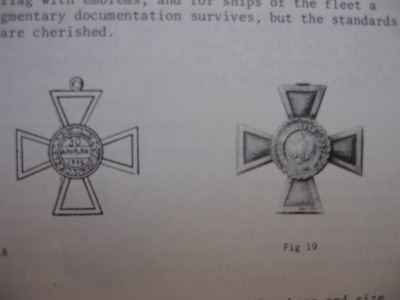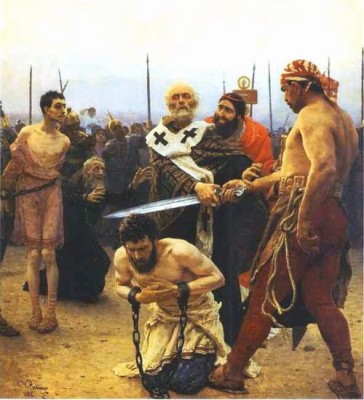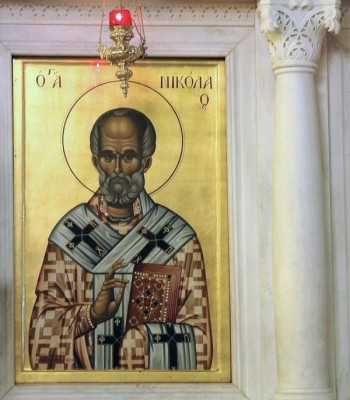The Russian Order Of St. Nicholas The Miracle Worker
Order of Saint Nicholas the Miracle-Worker
The course of the Great war on the Russian battlefield is generally in awareness. Disaster for the army was already February revolution Kerensky and the fall of tsarism and monarchy. Absolute disaster, not only for the Russian army, but also the whole society of Russia, however, was the "October revolution", which took place in November, but its disastrous consequences on own skin have felt the european states until the onset of Gorbačeova.
Instead of fighting, onset of chaos, instead of democracy comes the torture, the killings. For the Russian bolsheviks is a model of despotism and a time of Great bourgeois revolution in France in 1792, and they liked killing and humiliation of the nation and of the peoples of Russia.
The fight with Red, black,green and other groups are gradually passed on to the whole Rus and turn into a cruel civil war.
The last unit Dobrovolecké army of southern Russia ( about 120 000 ) soldiers under the command of general Denikin, after the defeat in Tauris (march 1920) in the exit fighting retreat to the Crimea. Among the 18. march, 1920, general Denikin surrendering the functions of the commander in chief and already 21. march 1920 takes over the function of the lieutenant general of the tsarist army, baron Petr Nikolaevich WRANGEL. General Wrangel becomes the head administrator of the roman army and a civilian in the Crimea. On his staff have found their place the military mission of France, England and more.
The remaining units of the volunteer army, mainly composed of officers, young students and cossack are closed on Perekopské the nape of the neck and on the Sivaši. They are surrounded and cut off, completely without help. The victorious powers lose interest in these military units, because at this time already koketuji with the bolsheviks with whom i have diplomatic relations.
The commanders of the higher military departments often wrongly used of the royal orders and decorations to the ceremony of their soldiers. General Wrangel, the personnel officer of the tsarist army, which was, inter alia, the bearer of the order of Sv. Vladimir III. degree with swords and Military order of St. George IV. degrees (see picture) refused, and later his orders even forbade the wearing of czarist decorations, collected in a fratricidal fight the civil war. But he also realized that bravery and heroism, united with patriotism of their soldiers, it is necessary to appreciate the visible ceremony and even in the last stages of the struggle in defense of access to the Crimea.
The foundation of the order:
The supreme commander, general Wrangel, on 30. April 1920 signed the order, which was from his will established the order of:
THE ORDER OF ST. NICHOLAS DIVOTVURCE.
The order was established in two stages and its award had to be confirmed by the so-called Dumou knights of the order. The actual award still had to be approved in the orders of the supreme commander. The statute of the order was based on the statute of the order of Sv. George. It is evident that this order was to replace the Military order of the Sv. George. The first nun, the Duma was composed of the knights of the order of Sv. George. But it was immediately complemented by the first knights of the order of Sv. Nicholas Divotvorce.
Maintain the archives of the order and so we know the first knight of the order. Became to them the staff captain Ljubin - Jarmolovič of 3. section 1. tank battalion for the manifest heroism and bravery in fending off units of the Red army, which led the attack on the Perekopské the nape of the neck. This order personally handed him a chief commander of the army, general Wrangel.
To the last grant still on the territory of Russia signed gen Wrangel 14. October, 1920, when he was order of the 2. degree awarded the lieutenant general Fostikov, the then chief of staff of the Černomořsko-Kubáňského clusters for bouncing and detention of the bolshevik offensive in the area Sevastopola.
The white army was clamped in the area of Sevastopol and so already at the beginning of November 1920 occurs to evacuate. Own evacuation was carried out in the ports of Sevastopol, Feodesia and Kerch with the help of the Russian fleet, on the ship France and England and has been for the rumble of bolshevik art. Day 2. November is, therefore, this action on an unprecedented scale terminated. On board the Russian cruiser "General Kornilov" in the County of the port in Sevastopol is symbolically the last with his staff and part of the Russian government board and the Chief commander of the army of general Wrangel. A course for Constantinople in Turkey. General Wrangel never return to Russia.
For proven bravery, courage verging on self-immolation in the implementation of their own resettlement units (evacuation) of the army and the population of the distinguished admiral Wrangel 5. November on board the cruisers of the five-member group, navy commanders on the forehead with kontraadmirálem N. Mašukovem. Provably the last award of the order occurs 6. December 1920 colonel To.P. Gordijenkovi and vojskovému staršinovi N.And. Kutějnikovi .
Additional staffing orders with the signature of general Wrangel on the granting of the order has already been signed and dated on the territory of Turkey in the camp of Gallipoli ,where there were the remnants of the army concentrated and interned.
The numbers of the privileges of the order's badges:
On the territory of Russia in the time from the foundation 30.April to 5. November 1920 it was granted a total of 95 of the order's decorations 2. instance. Beyond the borders of Russia, after the evacuation of the troops it is then other 243 orders of magnitude 2. the degree of officers of army units and the fleet. Knight Duma at its meeting in Gallipoli at the conclusion of December in the year of 1920 granted the order of St. Nicholas-the miracle worker 2. the degree of generálporučíkovi Wrangelovi, which also in the emigration of the order wore for his cross of the order Sv. George IV. instance. Completely to the final decorating of this order occurred 12. June 1920 : the Order of the received second lieutenant In the. Dobrovolskij and chorunži (ensign ?) To.Dorofěv. This last point graduation is concluded the history of this procedure, which could become famous.
Description of the jewel:
The order was founded in the spirit of the statutes of the illustrious order of Sv. George. Even the size of the order is the same as with the crosses of the order Sv. George IV. and III. instance. The center medallion of the order Sv. Nicholas is he enameled and the foreside is located the image of St. Nicholas - Divotvorce. Around the ring is in cyrillic decomposed inscription:
VEROJ SPASAJETSJA ROSSIJA
So as Sv. George i of this order had its deviation determined nekřesťanům.. it Was also the national emblem in the form of a black two-headed eagle.
The reverse side bears in the centre a medallion bílomodročervená enamelled tricolour in horizontal stripes. There is engraved the date of the foundation of the order: "30. APRELJA 1920". Order date was set 9. may.
The contract to produce the first specimens of the orders was handed over to the company CONVENIENCE Berlin (known for its high-quality minting of the prussian orders of magnitude and Iron cross). There have been a total constructed:
10 pcs of the order of crosses 1. the degree of
50 pcs the order of the crosses 2. the degree of
10 pcs of the order of the crosses 2. grades for non-christians
Other architectural jewels are made in different countries, particularly in Yugoslavia, France (they'll turn even in Bulgaria). These crosses, however, are already of inferior quality.
RIBBON:
The jewel of the order is suspended on a ribbon in the colors of the Russian tricolor (white-blue-red ). The ribbon is the wide 28 mm, made in the traditional Russian pentagon and attached to the metal kolodku.
It is not known to me, that on our territory the order was struck. It is not known to me, that the original of the cross was in some of our Czech, moravian or Slovak collection. But its meaning and the tragic fate of the majority of holders of the order certainly merits at least a memory.
Note:
Saint Nicholas had and has in the Czech lands of their own, the christian position. In his memory we know, among other churches dedicated to just Sv. Nicholas (Prague), but also other monuments, paintings and relics .
Literature :
General Paskov: honours civil war 1917-1922
Velkov With.In.: The tragedy of the Russian officers. Moscow 1999
Fidler J.: Generals legionaries. Brno 1999
And.And. von Lampe: The Order of St. Nicholas the Miracle-worker. 1937.
Order of Saint Nicholas the Miracle-Worker
The course of the Great war on the Russian battlefield is generally in awareness. Disaster for the army was already February revolution Kerensky and the fall of tsarism and monarchy. Absolute disaster, not only for the Russian army, but also the whole society of Russia, however, was the "October revolution", which took place in November, but its disastrous consequences on own skin have felt the european states until the onset of Gorbačeova.
Instead of fighting, onset of chaos, instead of democracy comes the torture, the killings. For the Russian bolsheviks is a model of despotism and a time of Great bourgeois revolution in France in 1792, and they liked killing and humiliation of the nation and of the peoples of Russia.
The fight with Red, black,green and other groups are gradually passed on to the whole Rus and turn into a cruel civil war.
The last unit Dobrovolecké army of southern Russia ( about 120 000 ) soldiers under the command of general Denikin, after the defeat in Tauris (march 1920) in the exit fighting retreat to the Crimea. Among the 18. march, 1920, general Denikin surrendering the functions of the commander in chief and already 21. march 1920 takes over the function of the lieutenant general of the tsarist army, baron Petr Nikolaevich WRANGEL. General Wrangel becomes the head administrator of the roman army and a civilian in the Crimea. On his staff have found their place the military mission of France, England and more.
The remaining units of the volunteer army, mainly composed of officers, young students and cossack are closed on Perekopské the nape of the neck and on the Sivaši. They are surrounded and cut off, completely without help. The victorious powers lose interest in these military units, because at this time already koketuji with the bolsheviks with whom i have diplomatic relations.
The commanders of the higher military departments often wrongly used of the royal orders and decorations to the ceremony of their soldiers. General Wrangel, the personnel officer of the tsarist army, which was, inter alia, the bearer of the order of Sv. Vladimir III. degree with swords and Military order of St. George IV. degrees (see picture) refused, and later his orders even forbade the wearing of czarist decorations, collected in a fratricidal fight the civil war. But he also realized that bravery and heroism, united with patriotism of their soldiers, it is necessary to appreciate the visible ceremony and even in the last stages of the struggle in defense of access to the Crimea.
The foundation of the order:
The supreme commander, general Wrangel, on 30. April 1920 signed the order, which was from his will established the order of:
THE ORDER OF ST. NICHOLAS DIVOTVURCE.
The order was established in two stages and its award had to be confirmed by the so-called Dumou knights of the order. The actual award still had to be approved in the orders of the supreme commander. The statute of the order was based on the statute of the order of Sv. George. It is evident that this order was to replace the Military order of the Sv. George. The first nun, the Duma was composed of the knights of the order of Sv. George. But it was immediately complemented by the first knights of the order of Sv. Nicholas Divotvorce.
Maintain the archives of the order and so we know the first knight of the order. Became to them the staff captain Ljubin - Jarmolovič of 3. section 1. tank battalion for the manifest heroism and bravery in fending off units of the Red army, which led the attack on the Perekopské the nape of the neck. This order personally handed him a chief commander of the army, general Wrangel.
To the last grant still on the territory of Russia signed gen Wrangel 14. October, 1920, when he was order of the 2. degree awarded the lieutenant general Fostikov, the then chief of staff of the Černomořsko-Kubáňského clusters for bouncing and detention of the bolshevik offensive in the area Sevastopola.
The white army was clamped in the area of Sevastopol and so already at the beginning of November 1920 occurs to evacuate. Own evacuation was carried out in the ports of Sevastopol, Feodesia and Kerch with the help of the Russian fleet, on the ship France and England and has been for the rumble of bolshevik art. Day 2. November is, therefore, this action on an unprecedented scale terminated. On board the Russian cruiser "General Kornilov" in the County of the port in Sevastopol is symbolically the last with his staff and part of the Russian government board and the Chief commander of the army of general Wrangel. A course for Constantinople in Turkey. General Wrangel never return to Russia.
For proven bravery, courage verging on self-immolation in the implementation of their own resettlement units (evacuation) of the army and the population of the distinguished admiral Wrangel 5. November on board the cruisers of the five-member group, navy commanders on the forehead with kontraadmirálem N. Mašukovem. Provably the last award of the order occurs 6. December 1920 colonel To.P. Gordijenkovi and vojskovému staršinovi N.And. Kutějnikovi .
Additional staffing orders with the signature of general Wrangel on the granting of the order has already been signed and dated on the territory of Turkey in the camp of Gallipoli ,where there were the remnants of the army concentrated and interned.
The numbers of the privileges of the order's badges:
On the territory of Russia in the time from the foundation 30.April to 5. November 1920 it was granted a total of 95 of the order's decorations 2. instance. Beyond the borders of Russia, after the evacuation of the troops it is then other 243 orders of magnitude 2. the degree of officers of army units and the fleet. Knight Duma at its meeting in Gallipoli at the conclusion of December in the year of 1920 granted the order of St. Nicholas-the miracle worker 2. the degree of generálporučíkovi Wrangelovi, which also in the emigration of the order wore for his cross of the order Sv. George IV. instance. Completely to the final decorating of this order occurred 12. June 1920 : the Order of the received second lieutenant In the. Dobrovolskij and chorunži (ensign ?) To.Dorofěv. This last point graduation is concluded the history of this procedure, which could become famous.
Description of the jewel:
The order was founded in the spirit of the statutes of the illustrious order of Sv. George. Even the size of the order is the same as with the crosses of the order Sv. George IV. and III. instance. The center medallion of the order Sv. Nicholas is he enameled and the foreside is located the image of St. Nicholas - Divotvorce. Around the ring is in cyrillic decomposed inscription:
VEROJ SPASAJETSJA ROSSIJA
So as Sv. George i of this order had its deviation determined nekřesťanům.. it Was also the national emblem in the form of a black two-headed eagle.
The reverse side bears in the centre a medallion bílomodročervená enamelled tricolour in horizontal stripes. There is engraved the date of the foundation of the order: "30. APRELJA 1920". Order date was set 9. may.
The contract to produce the first specimens of the orders was handed over to the company CONVENIENCE Berlin (known for its high-quality minting of the prussian orders of magnitude and Iron cross). There have been a total constructed:
10 pcs of the order of crosses 1. the degree of
50 pcs the order of the crosses 2. the degree of
10 pcs of the order of the crosses 2. grades for non-christians
Other architectural jewels are made in different countries, particularly in Yugoslavia, France (they'll turn even in Bulgaria). These crosses, however, are already of inferior quality.
RIBBON:
The jewel of the order is suspended on a ribbon in the colors of the Russian tricolor (white-blue-red ). The ribbon is the wide 28 mm, made in the traditional Russian pentagon and attached to the metal kolodku.
It is not known to me, that on our territory the order was struck. It is not known to me, that the original of the cross was in some of our Czech, moravian or Slovak collection. But its meaning and the tragic fate of the majority of holders of the order certainly merits at least a memory.
Note:
Saint Nicholas had and has in the Czech lands of their own, the christian position. In his memory we know, among other churches dedicated to just Sv. Nicholas (Prague), but also other monuments, paintings and relics .
Literature :
General Paskov: honours civil war 1917-1922
Velkov With.In.: The tragedy of the Russian officers. Moscow 1999
Fidler J.: Generals legionaries. Brno 1999
And.And. von Lampe: The Order of St. Nicholas the Miracle-worker. 1937.



